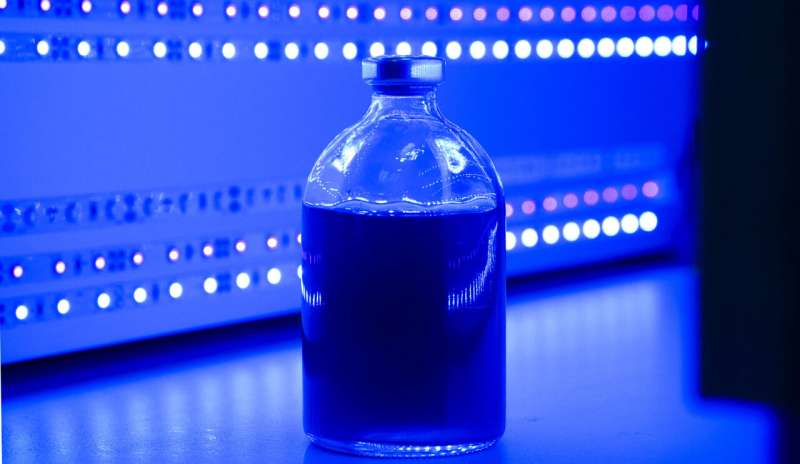This article has been reviewed according to Science X's editorial process and policies. Editors have highlighted the following attributes while ensuring the content's credibility:
fact-checked
peer-reviewed publication
trusted source
proofread
Findings challenge current understanding of nitrogenases and highlight their potential for sustainable bioproduction

Nitrogenases are among the most geochemically important enzymes on Earth, providing all forms of life with bioavailable nitrogen in the form of ammonia (NH3). Some nitrogenases can also directly convert CO2 into hydrocarbon chains, making them an exciting target for the development of biotechnological processes.
A team of researchers in Marburg, Germany, led by Max Planck scientist Johannes Rebelein, has now provided a comprehensive insight into the substrate specificity and preferences of nitrogenase. Their results challenge the current understanding of nitrogenases and highlight their potential for sustainable bioproduction. The research is published in the journal Science Advances.
Nitrogen is one of the main building blocks of our cells. However, most of the nitrogen on Earth occurs as gaseous N2 and is chemically unusable by cells. Only a single family of enzymes is able to convert N2 into the bioavailable form of ammonia (NH3): nitrogenases.
Researchers led by Johannes Rebelein from the Max Planck Institute for Terrestrial Microbiology in Marburg have discovered that some nitrogenases can also deal with another important substrate: They reduce the greenhouse gas CO2 to hydrocarbons (methane, ethylene, ethane) and formic acid.
All these products are potential energy sources and industrially important chemicals. With a view to sustainable, carbon-neutral bioproduction, the team wanted to know: How well can the enzymes discriminate between CO2 and N2? And do microorganisms that grow on N2 also reduce CO2 under normal, physiological conditions?
Two isoenzymes
To answer these questions, the researchers focused on the photosynthetic bacterium Rhodobacter capsulatus, which harbors two isoenzymes: the molybdenum (Mo) nitrogenase and the iron (Fe) nitrogenase, which the bacterium needs as a reserve in the event of molybdenum deficiency.
The researchers isolated both nitrogenases and compared their CO2 reduction using biochemical tests. They found that the Fe nitrogenase actually reduces CO2 three times more efficiently than its molybdenum containing counterpart and produces formic acid and methane at atmospheric CO2 concentrations.
When both enzymes were offered CO2 and N2 at the same time, another important difference became apparent: while Mo-nitrogenase selectively reduces N2, Fe-nitrogenase tends to choose CO2 as a substrate.
"Normally, a higher reaction speed in enzymes comes at the expense of accuracy. Interestingly, Mo-nitrogenase is both faster and more selective, showing its advantage in N2 reduction. The lower specificity of Fe nitrogenase and its preference for CO2 make it a promising starting point for the development of novel CO2 reductases," says Frederik Schmidt, Ph.D. student in Johannes Rebelein's lab and co-author of the study.
Wide-spread CO2 reduction in nature?
The low selectivity was not the only surprise.
"We analyzed which fraction of electrons ended up in which product and found that methane and high concentrations of formic acid derived from CO2 conversion by Fe nitrogenase were secreted by the bacteria even when no additional CO2 was added to the culture: the metabolically derived CO2 was sufficient to drive this process. This finding suggests that Fe nitrogenase-catalyzed CO2 reduction may indeed be widespread in nature," says Niels Oehlmann, co-first author of the study.
This also means that the availability and exchange of one-carbon substrates is likely to influence microbial communities in different environments.
The work challenges the traditional view of nitrogenases as true nitrogen-converting enzymes. Photosynthetic bacteria such as R. capsulatus, which use light energy to stimulate nitrogenases to convert the greenhouse gas CO2, could play a key role not only in their environmental impact, but also in the societal shift towards a sustainable circular economy, says Johannes Rebelein.
"The idea is that we can store the energy from the sunlight captured by the microorganism's photosynthetic apparatus in the hydrocarbons produced by nitrogenase. In the future, we want to further develop the iron nitrogenase in order to use it for CO2 fixation and utilization."
More information: Niels Oehlmann et al, The Iron Nitrogenase Reduces Carbon Dioxide to Formate and Methane under Physiological Conditions: A Route to Feedstock Chemicals, Science Advances (2024). DOI: 10.1126/sciadv.ado7729. www.science.org/doi/10.1126/sciadv.ado7729
Journal information: Science Advances
Provided by Max Planck Society




















